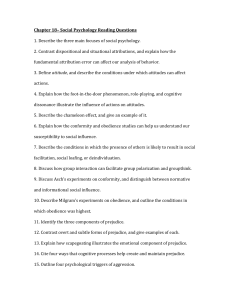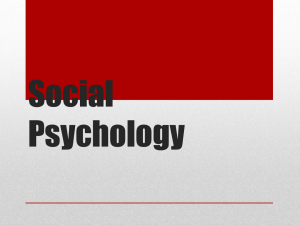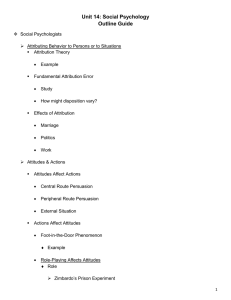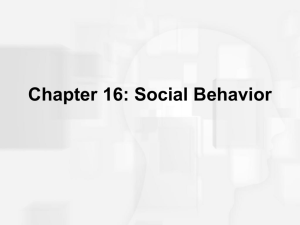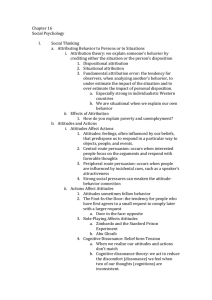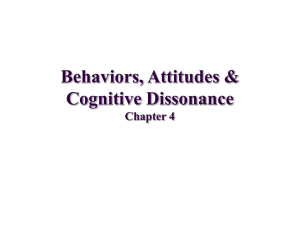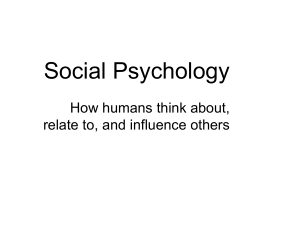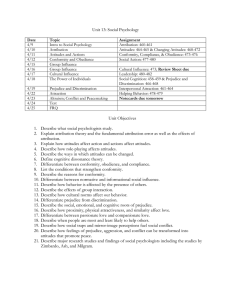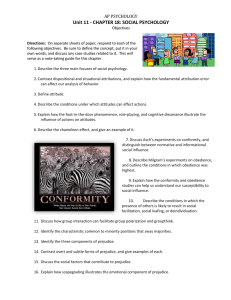social proof.
advertisement
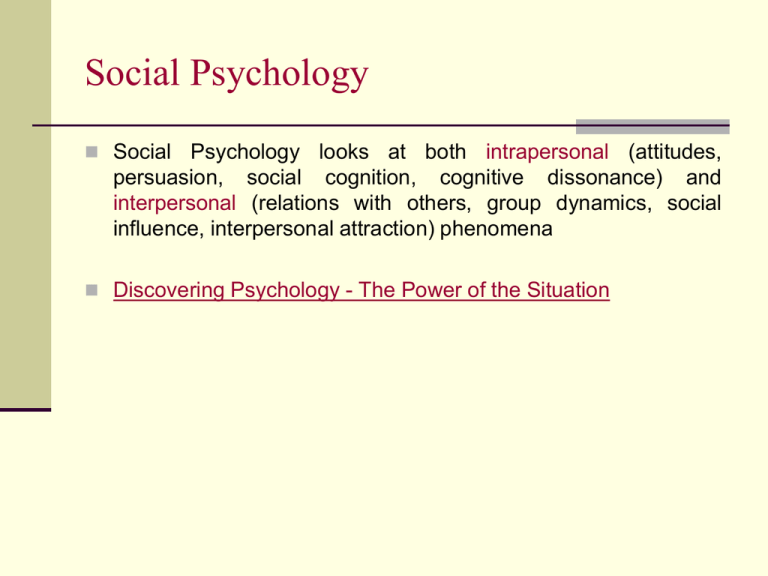
Social Psychology Social Psychology looks at both intrapersonal (attitudes, persuasion, social cognition, cognitive dissonance) and interpersonal (relations with others, group dynamics, social influence, interpersonal attraction) phenomena Discovering Psychology - The Power of the Situation Attribution Process and Theory How we attach meaning to other’s behavior, or our own, is called attribution Attribution theory (Fritz Heider) People naturally see cause and effect relationships and seek to explain behavior Attribution Process and Theory Attribution theory (Fritz Heider) Dispositional versus situational attribution Fundamental attribution error (others) Self-serving bias (also defensive attribution) self only Actor-observer effect Why were you late for class? Why was Jimmy late for class? Why did you fail the Psych test? Jimmy? Just-world hypothesis Cognitive Dissonance Cognitive dissonance The tension caused by holding two contradictory ideas simultaneously. Includes attitudes and beliefs, and actions Theory of cognitive dissonance proposes that people seek to reduce dissonance by changing their attitudes, beliefs, or behaviors, or by justifying or rationalizing their attitudes, beliefs, and behaviors in order to seek cognitive consistency (Festinger) Cognitive Dissonance: Attitudes and Actions According to Leon Festinger we seek cognitive consistency by bringing our attitudes closer to our actions called theory of cognitive dissonance or balance theory Tedious task experiment $$ (Festinger) Festinger CD A(ttitude)-B(ehavior) Problem – To what extent do behaviors affect attitudes? Can one predict the other? Cognitive Dissonance and Behavior Role playing Subjects in a role often begin to “become” the role. Behavior affects attitudes and reduces dissonance (e.g. role playing – “I’m a teacher, dad, scholar…”) Zimbardo prison pathology experiments Foot-in-the-door theory The tendency for people who agree to a small request to comply later with a larger one (cheating, lying, drug use, torture…it’s a slippery slope!). Reduces initial dissonance. Also used in persuasion/sales Effort justification the tendency to find something more attractive if you have to work hard to achieve it, Examples? Role Playing and Zimbardo • Zimbardo prison experiments • Role playing and deindividuation and situational influences •ZimbardoPE •Zimbardo DN •The Stanford Prison Experiment Deindividuation Deindividuation into a group results in a loss of individual identity and a gaining of the social identity of the group. Examples? Anonymity Diffused responsibility Group size The Lucifer Effect: Abu Ghraib Daily Show Zimbardo Social Influence and Conformity & Obedience Conformity influences the maintenance of social norms and allows society to function smoothly Other behaviors may be an expression of compliance (obedience) toward authority Conformity Obedience Social Conformity (Asch) Asch’s conformity experiments Asch study What are the factors which affect degree of conformity? Normative social influence v. Informational social influence Reasons for Conformity Normative Social Influence Results from a person’s desire to gain approval or avoid rejection. Public compliance, but doubt. Number, strength and immediacy. Asch Conformity Studies Two polar bears are sitting in a bathtub. The first one says, "Pass the soap". The second one says, "No soap, radio!" (anti-humor – false and negative understanding) ConformityCC Reasons for Conformity Informational Social Influence Look to group to make accurate judgments Also called social proof. It occurs most often when The situation is ambiguous. There is a crisis. We have no time to think and experiment. A decision is required now! Other Types of Conformity & Phenomena Chameleon effect Mood linkage (emotional or social contagion) Suggestibility Obedience to Authority The Milgram Experiments Milgram Video The Power of the Situation Social Obedience (Milgram) Results and Explanations for Milgram’s Obedience to Authority experiments Socialization (normative influence) Foot in the door phenomenon Perception of legitimate authority Diffusion of responsibility Inaccessibility of values Lack of social comparison Physical and psychological buffers (proximity, depersonalization) Ethicality of the experiment? Social Identity Theory and Prejudice Social Identity Theory Identity is formed through the groups to which we belong. We are motivated to improve the image and status of our own group in comparison with others (Tajfel) Categorizing people (including oneself) into ingroups or outgroups affects perceptions, attitudes, and behavior (key source of prejudice and discrimination) Tajfel and Social Identity Theory Social Identity Theory and Prejudice Group Dynamics and Prejudice Sherif’s Robbers Cave experiment (1961) Realistic Conflict Theory Limited resources lead to conflict between groups and result in prejudice, discrimination and stereotypes within a society In Group homogeneity and Out Group bias (basis of stereotype and prejudice). Stages: 1) In Group formation 2) friction and competition and 3) integration Superordinate goals Contact hypothesis GRIT PsyBlog: War, Peace and the Role of Power in Sherif's Robbers Cave Experiment Prejudice and Discrimination Prejudice is an unjustifiable (usually negative) attitude toward a group and its members. Prejudice underlies the behavior of discrimination Components of Prejudice 1. 2. 3. Beliefs (stereotypes) Emotions (hostility, envy, fear) Predisposition to act (to discriminate) Social, Emotional and Cognitive Roots of Prejudice Social inequality, social division and emotional outgroup and ingroup bias An outlet for blame, anger and resentment Scapegoat Theory Just world phenomenon Unconscious Prejudice Prejudice works at the conscious and [even more at] the unconscious level. Prejudice is more a knee-jerk response than a conscious decision which then results in behavior (discrimination) Implicit Association Test Discrimination – A Class Divided Group Dynamics How does the presence of others influence individual behavior? Social loafing Social facilitation Group polarization (incestuous amplification and risky shift) not groupthink Deindividuation Groupthink (rationalized conformity) and mindguard Groupthink and Mindguard Groupthink When norms for conforming in a homogeneous group become so strong, and members are so highly concerned about maintaining unanimity, that they fail to critically evaluate their options and consequently make a poor decision Examples...Iraq invasion, Bay of Pigs, Challenger disaster… Role of mindguard Bystander Effect Bystander intervention v. bystander apathy/effect (Kitty Genovese) First demonstrated by Darley and Latane (1968) Participants are assigned to alone or group condition (comprised of confederates). A crisis situation is staged; a person getting injured, a person having a seizure...How do participants react? Consistent Results: The presence of others inhibits helping… Diffusion of responsibility/social loafing Pluralistic ignorance Bystander intervention The Psychology of Helping Altruistic and Prosocial behavior Social norms theory States that much of people’s behavior is influenced by their perception of how other members of their social group behave Social exchange theory An economic-social theory that assumes human relationships are based on choice and costbenefit analyses = Social benefits If one partner's costs begin to outweigh his or her benefits, that person may leave the relationship, especially if there are good alternatives available Theory of Social Comparison Theory of Social Comparison (Festinger) Humans gain information about themselves, and source selfesteem, by comparison to others Upward social comparison Individuals compare themselves to others who are “socially better” to view self more positively Downward social comparison A defensive tendency to evaluate oneself in comparison with others whose troubles are more serious than one's own Persuasion and the Elaboration Likelihood Model Persuasion can be divided into two separate processes based on the "likelihood of cognitive elaborations," that is, whether people think critically about the content of a message, or respond to superficial aspects of the message and other immediate cues Central and persuasion peripheral routes to The Psychology of Aggression Bio-psychosocial model Biological Sources/Causes (brain, hormones, genetics, evolutionary - instinct theory) Psychological sources Social scripts Observational learning and reinforcements Frustration-aggression hypothesis Psychology of Attraction Factors affecting attraction Proximity/propinquity – mere exposure effect Primacy (first impressions) Physical attractiveness (facial matching) Similarity Complementarity (not dissimilarity) Reward theory of attraction/social exchange Intimacy Theories of interpersonal attraction – reinforcement, equity and cognitive consistency (balance)
